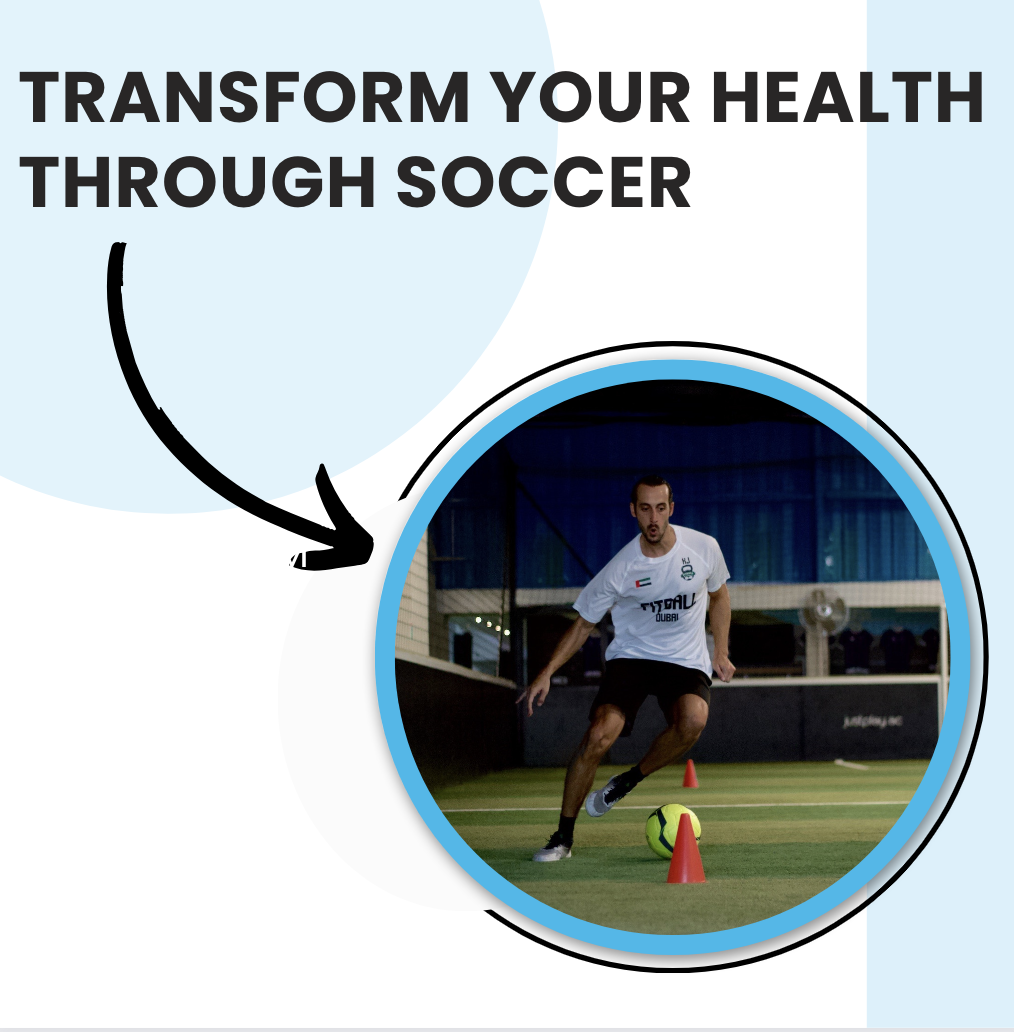I have had my bouts of low moods that at times, fallen into short-lived depressions.
I chalk a lot of this up to the inevitably of living in a world where you’re constantly reminded that you are not good enough. I want to address this topic in more detail at some point down the road.
But for now, let’s just say that some days, ever so often, I feel down.
And every time I feel down, the one thing that reliably kicks me back into gear is soccer.
I say this off the back of my last post : How to Reprogram Your Mind to Be Fit in 13 Minutes.
In that article, I discussed 6 rules that have been instrumental for creating and sustaining a healthy lifestyle, both for myself and my clients.
As a tangent to my overall wellness philosophy, I want to dive a little deeper into my domain of mastery.
Although I emphasize all types of exercise, I would be remiss if I didn’t provide the specific details that make soccer such an incredible avenue to follow in your fitness journey.
After all, there is a high likelihood you opted in to read my newsletter because of your particular interest in soccer-related fitness workouts.
If that is not the case, feel free to pass up on this read.
But for the rest of you, I would stay tuned.
Whether you’re a beginner who wants to learn the basics or you’re a former high-level player who wants to rediscover your best form, I’m going to provide numerous compelling reasons why you should choose Fitball.
Just to be clear, Fitball is a unique training system I created that incorporates fitness with soccer drills in a HIIT style workout. You can view an example workout here.
Below I want to discuss not just the benefits of Fitball, but soccer as a whole.
Mood enhancement and social reinforcement
The amount of times I have flipped a horrible day on it’s head courtesy of a kick about with some friends is undeniable.
It has so often been the medicine I’ve needed to push through a difficult time.
I’ve also noticed the better I play, the better I feel.
This means that the act of improving my overall fitness and soccer abilities leads to better performance. Better performance reinforces better mood. Better mood reinforces consistency.
And like that, it becomes a self fulfilling prophecy.
But I don’t have to necessarily go so deep.
At the surface, finding a group that you enjoy playing with is a great way to socialize. In fact, I’d argue it’s one of the best.
Or you could simply just pass the ball around or do some drills with friends, your partner or your children.
Regardless of how you engage with the ball, at it’s core, its a social endeavor that’s simple, fun and healthy.
This has beyond doubt sustained my love for the sport.
Training with your kids
Although soccer is not one of the most popular sports in the United States, it has one of the highest youth participation rates.
If you’re an involved parent with soccer players in your household, you should be paying attention.
What better way to encourage their development than to train with them?
We all know time is a limited resource, and this becomes most obvious when you have kids.
Fitball offers an opportunity to:
- Spend quality time with your children
- Exercise and workout simultaneously
- Lead my example and encourage your children’s participation
- Learn a new skill and develop alongside your children
Stimulus impact on body and longevity
Since I was 6 years old, my friends and I loved playing soccer together.
And we played a lot.
I’m talking all 3 recesses, club teams, P.E. classes, varsity, etc.
No one every forced us to play. We did it because we loved it.
Since then, almost every single one of them has stopped.
Careers, families and adult responsibilities started to take priority over physical exercise.
On the occasion where a game could be squeezed in, their bodies and technical abilities were not there.
The outcome : demoralization and injury.
Then the fateful conversation, ‘Kam, I don’t think I can play anymore, my body is giving up on me”
This, mind you, were words uttered by a 28-year old — a prime age to being playing soccer.
The truth is, they gave up on their body.
If you’re conscientious about your health, you can even play into your 60s.
This is commonplace among the elderly in Brazil and other soccer-obsessed countries.
In fact, look up Kazuyoshi Miura now. At 56 years old, he is still playing professionally in Japan.
I see the relationship between soccer and fitness as a two-way street.
That means on one hand, I like to remain fit to play soccer.
And on the other, I use soccer as a tool to get in shape.
As a sport, soccer has a number of unique characteristics that have helped me achieve desired outcomes. I will cover them in the details below.
Functional Fitness and Athleticism
Functional fitness has become all the rage these days. For those unfamiliar, it’s a type of training that primes your body for the movements you do in everyday life.
The idea is, instead of just building muscle, you engage in exercise that increases strength and mobility in order to reduce the risk of injury, improve coordination, and improve cardiovascular fitness amongst other things.
In this vein, I don’t think there is a better activity for facilitating functional fitness than soccer.
And we can think about it like this.
Most sports are hand-eye coordinated. That means that when someone participates in baseball or basketball, they are often strengthening the neural pathways to their upper extremities (hands and arms).
Soccer is the only major sport that is predominantly lower-extremity focused. This means every time you participate with the ball, you are firing neurons to your legs and feet disproportionately more than other activities (dance is another great activity to engage lower body coordination).
The outcome of this over time is improved balance, coordination, stability and athleticism.
This is significant for one main reason.
Our day-to-day lives primarily center around using the dexterity of our hands, so in essence, our lower extremities are generally underserved. Falls and associated injuries typically occur because of an uncoordinated and unconditioned lower body.
So by utilizing the soccer ball as a tool to challenge your footwork, you can substantially improve coordination and balance.
And I know this anecdotally.
Because I’ve played soccer most of my life, I have deep neural pathways engrained in my lower extremities. The spill over benefits of this become apparent when I dance.
Adept dancing requires a considerable amount of full body coordination, especially from the lower body. And despite having no formal training, I’m repeatedly complimented on my dancing abilities.
Don’t get me wrong, I am by no means Michael Jackson.
But the fact that I can move with commendable rhythm, balance and coordination can only be explained by my years of kicking a ball.
Perfect recipe for a lean, healthy physique
I never understood men’s obsession with being ginormous, even at the expense of their own health.
If it’s to appear more attractive to the opposite sex, then they should reconsider their motives
According to hard science (I’m joking, this is a GQ article), the soccer bod is the most attractive body type.
Now, you should take this with a grain of salt as this is completely subjective.
If you want to build tree trunks thighs and Hulk Hogan traps, have at it.
But for me, the ideal body type has always been a top-heavy soccer player’s body (soccer player’s tend to be skinny waist up and I prefer a more built upper body).
Suffice to say, the high-intensity stop-start nature of the sport and the specific ways that I incorporate ball drills into interval training has enabled me to build the type of body I want.
Enhancement to overall health markers
Besides being optimal for building a coordinated, athletic physique, I would be remiss if I didn’t cover the obvious health benefits of Fitball.
The demands of a soccer game most closely resemble interval training. Interval training involves alternating short bursts of high-intensity activity with periods of rest or low-intensity activity
Fitball incorporates a lot of high-intensity interval training (HIIT), specifically using the ball to challenge the cardiovascular and nervous system.
If you want to know the impact the ball has on challenging your cardio, I encourage you to set up a 5 line shuttle sprint and perform it at maximum speed. Now do it while dribbling the ball.
You will feel the difference, trust me.
Here is a non-exhaustive list of the benefits of Fitball training:
- More efficient: Like any interval-style training, Fitball burns more calories in less time than steady state cardio. This is because your body continues to burn calories after you have finished exercising, due to the EPOC effect (excess post-exercise oxygen consumption).
- Improves cardiovascular fitness: Fitball is very effective at improving cardiovascular fitness and improving your VO2 max (amount of oxygen your body can consumer during exercise). This is because it challenges your heart and lungs to work harder than they would during regular workouts.
- Improves insulin sensitivity: Fitball can help to improve insulin sensitivity, which is important for blood sugar control.
- Stronger muscles and bones: Fitball is a weight-bearing exercise with plyometric elements, which means that it puts stress on the bones and muscles. This helps to strengthen the bones and prevent osteoporosis, and it helps to build muscle mass and strength.
To Recap…

